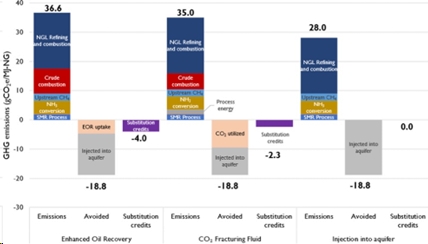Studies Explore Potential for Carbon Neutral Natural Gas Systems
Outcome/Accomplishment
Researchers in the Center for Innovative and Strategic Transformation of Alkane Resources (CISTAR) have examined how integrating natural gas production with enhanced oil recovery or CO2-based fracturing could push natural gas systems toward carbon neutrality. This type of integration could reduce net greenhouse gas emissions of natural gas production and use to 28 g CO2e/MJ from 88 g CO2e/MJ, a substantial reduction of 69%. Nonetheless, it is not possible to achieve full decarbonization with this approach, which relies on existing technologies and systems. Multiple avenues for full decarbonization are being pursued at CISTAR.
Impact/Benefits
Shale gas is a critical domestic energy resource in the United States, but its production and use contribute substantially to greenhouse gas emissions. Within CISTAR, researchers are exploring how to use natural gas and co-produced natural gas liquids to support the advancement of lower-emitting energy systems such as biofuels and energy storage technologies that use batteries. The potential to achieve a 69% GHG reduction, which encompasses GHG emissions along the full natural gas supply chain from extraction to use, is therefore notable.
Explanation/Background
: It is important to consider how to responsibly use natural gas and natural gas liquids in an environmentally responsible manner as a bridge towards a low-carbon energy future. Within CISTAR, technology is under development to produce fuels from natural gas liquids in a zero emissions process, but the natural gas liquids and co-produced natural gas add to the life-cycle greenhouse gas emissions of these fuels due to emissions during upstream extraction and processing. In the near term, one emissions-reduction concept is to use the natural gas to produce H2 and CO2. The H2 can be used as a complement to existing H2 supplies as the hydrogen economy expands. The CO2 can be sequestered underground through enhanced oil extraction, a mature technology. However, to understand the systems-level effect of using CO2 in this way, it is important to account for the combustion of the oil that is recovered. Similiarly, CO2 could be used as a fracking fluid and be sequestered underground. This approach, however, produces more gas that will be combusted. These two scenarios, at a system level, have roughly equivalent emissions--which are 69% lower than baseline natural gas system emissions.
Ideally, however, uses of natural gas in the future will not lead to the combustion of additional fossil fuels. Other scenarios under exploration see the co-produced H2 from SMR used in the hydrogenation process for biofuel production. Furthermore, it is possible to produce graphite from natural gas and use the graphite in energy storage technologies, including lithium-ion batteries, that are experiencing a boom in demand. CISTAR continues to explore potential scenarios for environmentally responsible, carbon-neutral natural gas systems as the nation moves towards the goal of net zero emissions by 2050.
Location
West Lafayette, Indianawebsite
Start Year
Energy and Sustainability
Energy, Sustainability, and Infrastructure
Lead Institution
Core Partners
Fact Sheet
Outcome/Accomplishment
Researchers in the Center for Innovative and Strategic Transformation of Alkane Resources (CISTAR) have examined how integrating natural gas production with enhanced oil recovery or CO2-based fracturing could push natural gas systems toward carbon neutrality. This type of integration could reduce net greenhouse gas emissions of natural gas production and use to 28 g CO2e/MJ from 88 g CO2e/MJ, a substantial reduction of 69%. Nonetheless, it is not possible to achieve full decarbonization with this approach, which relies on existing technologies and systems. Multiple avenues for full decarbonization are being pursued at CISTAR.
Location
West Lafayette, Indianawebsite
Start Year
Energy and Sustainability
Energy, Sustainability, and Infrastructure
Lead Institution
Core Partners
Fact Sheet
Impact/benefits
Shale gas is a critical domestic energy resource in the United States, but its production and use contribute substantially to greenhouse gas emissions. Within CISTAR, researchers are exploring how to use natural gas and co-produced natural gas liquids to support the advancement of lower-emitting energy systems such as biofuels and energy storage technologies that use batteries. The potential to achieve a 69% GHG reduction, which encompasses GHG emissions along the full natural gas supply chain from extraction to use, is therefore notable.
Explanation/Background
: It is important to consider how to responsibly use natural gas and natural gas liquids in an environmentally responsible manner as a bridge towards a low-carbon energy future. Within CISTAR, technology is under development to produce fuels from natural gas liquids in a zero emissions process, but the natural gas liquids and co-produced natural gas add to the life-cycle greenhouse gas emissions of these fuels due to emissions during upstream extraction and processing. In the near term, one emissions-reduction concept is to use the natural gas to produce H2 and CO2. The H2 can be used as a complement to existing H2 supplies as the hydrogen economy expands. The CO2 can be sequestered underground through enhanced oil extraction, a mature technology. However, to understand the systems-level effect of using CO2 in this way, it is important to account for the combustion of the oil that is recovered. Similiarly, CO2 could be used as a fracking fluid and be sequestered underground. This approach, however, produces more gas that will be combusted. These two scenarios, at a system level, have roughly equivalent emissions--which are 69% lower than baseline natural gas system emissions.
Ideally, however, uses of natural gas in the future will not lead to the combustion of additional fossil fuels. Other scenarios under exploration see the co-produced H2 from SMR used in the hydrogenation process for biofuel production. Furthermore, it is possible to produce graphite from natural gas and use the graphite in energy storage technologies, including lithium-ion batteries, that are experiencing a boom in demand. CISTAR continues to explore potential scenarios for environmentally responsible, carbon-neutral natural gas systems as the nation moves towards the goal of net zero emissions by 2050.

